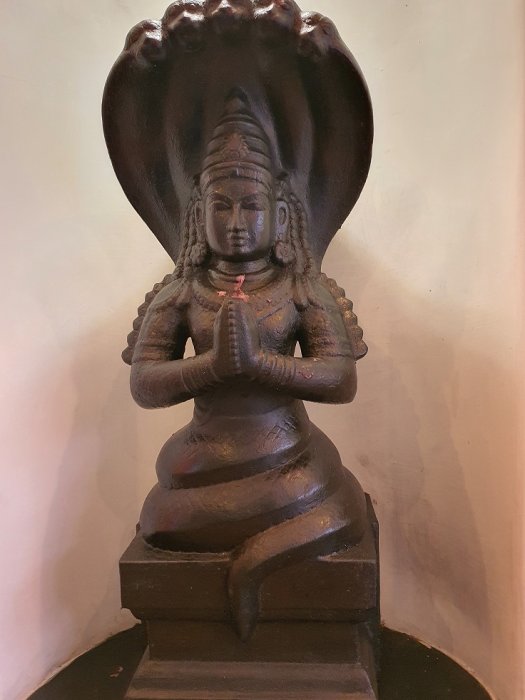When the word DEVADASI was substituted with ISAI VELLALAR, the women stepped back and the men stepped forward.
The English language is a privilege and a burden.
We need a new glossary of terms with which to discuss the dance history of South India.
Pass the mic but don’t stop speaking.
- Quotes from Prof. Avanthi Meduri’s Facebook conversation with Dr. Swarnamalya Ganesh on DEVADASI- HISTORY, IDENTITY, POLITICS, PRIVILEGE, July 30, 2020

Patanjali
There is a beautiful image as imagined by PATANJALI, the originator of Yoga.
STHIRAM and SUKHAM - - Stability and Ease
It stems from the pose of Vishnu reclined upon the serpent Adisesha while floating on the milky ocean. How adeptly the serpent has to adjust the coils so that the Lord can continue to sleep. For Mahavishnu to experience SUKHAM (ease), Adisesha has to practice STHIRAM (stability-balance).
How does one flow in the YOGA OF DAILY LIVING using these two images?
How does one live life with these two words as metaphors or gateways to harmony?
We now know that these past 4 months are going to last for at least another 8.
That this year should now be referred to as #DELETE2020.
That we are now locked in a DIGITAL EMBRACE into the first quarter of 2021.
So how do we even begin to consider the ideas of STHIRAM and SUKHAM?
How can we even fathom these qualities when everything around us is being thrown into disarray?
We are off balance more than ever.
There is less and less inspiration and motivation to continue to feel optimistic and positive about life and art.
So how can we even begin to understand SUKHAM?
The cheerleading squad who proclaim that "Dance can surmount anything" now sound weak and unconvincing.
We see depression, melancholia and listlessness all around and even the best and strongest among us are feeling vaguely unsettled.
Read more in the site
FACT: When we imagine abuse, often we get the image of a woman walking late in the night being attacked by a stranger in the darkness. Although abuse from strangers does happen, statistics actually show that 82-90% of all abuse is committed by people we know and even trust. Abuse usually happens within a complicated context of power dynamics, grooming, gaslighting, honor, shame, and a culture of silence that would rather ignore and deny its existence, than believe its victims and turn against perpetrators whom often hold much power and influence. FACT: Only 1% of abusers ever spend a single day in jail. Victim-blaming/shaming attitudes from peers, colleagues, police, society, and sometimes even family prevent survivors from ever reporting to the police and then cases that are reported are often closed, despite the fact the only 2% of all abuse reports are ever proven to be false. Nevertheless, this is changing with the growing #metoo movement. FACT: Grooming is a predatory act of maneuvering another individual into a position that makes them more isolated, dependent, likely to trust, and more vulnerable to abusive behavior. Grooming blurs the lines around abuse and makes it more difficult to identify when it is happening, and more difficult for the victim to identify and talk about in retrospect. Many aspects of “grooming” (a common tactic used by abusers) and guru-shishya grooming have many parallels. However in the prior, the elements of trust and respect are instead turned on their head to cover abuse and protect the predator. The seven stages of grooming are: 1) identifying the victim 2) gaining trust of and access to the victim 3) becoming important and close to the victim 4) isolating the victim 5) secrecy about the abuse 6) repeated abuse 7) controlling the relationship. FACT: Tonic immobility is a neurobiological response of involuntary paralysis in which individuals can’t move or, in many cases, even speak. In animals, this reaction is considered an evolutionary adaptive defense to an attack by a predator when other forms of defense are not possible. This reaction has been observed in soldiers in battle, as well as in survivors of abuse. Studies have also shown that the physical and psychological affect of abuse on victims is similar to the victims of an attempted murder. This reveals the high level of trauma and feelings of complete immobility that the brain experiences when facing abuse. A scientific and psychological explanation for why, often, survivors can’t call out for help when being abused. FACT: The definition of abuse culture is a complex set of beliefs that encourage aggression and support violence against the less powerful. It’s a culture in which constant harrassment and assault against women is the norm and violence is a fact of life, inevitable as death or taxes. This violence, however, is neither biologically nor divinely ordained. Cultural dynamics have a significant impact on how society talks (or doesn’t talk at all) about abuse, often reinforcing power structures, especially those concerned with honour and shame. FACT: Stockholm Syndrome is real. It was originally developed to explain the phenomenon of hostages emotionally bonding with their captors. The name refers to a bank holdup in Stockholm, Sweden in 1973 when four people were held hostage for six days by two men. The hostages and their captors bonded with each other and the hostages actually came to see their captors as protecting them from the police. Subsequent research found that such a reaction had occurred in all the "hostage" groups studied, including abuse victims. Researchers have concluded that this seems to be a universal phenomenon which may be instinctive and thus play a survival function for victims of abuse. The victim’s need to survive psychologically is stronger than their impulse to hate the person who abusing them. This positive emotional bond with the abuser acts as a defense coping mechanism for the abused.
ReplyDelete